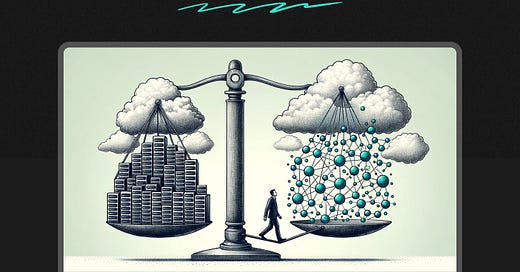Tech’s Continuum of Control
Centralization, decentralization, and the creators stuck in the middle
Welcome to Unknown Arts, where we explore the intersection of creativity and technology. Ready to forge ahead into the unknown? Join the journey!
A battle is underway.
Hidden beneath the buzzwords, the hype trains, and the charlatans, two powerful underlying tech forces continue to build momentum. On one hand, the force of centralization accelerates the concentration of power we’ve grown accustomed to in the FAANG generation of Big Tech. On the other hand, the force of decentralization pulls us back in the direction of the Internet’s distributed origins.
At the center, the people who make the Internet valuable, the Creators, get pulled in both directions. Centralizing technologies like AI promise godlike creative power to those who learn to wield it. Meanwhile, decentralizing technologies like blockchain offer the opportunity to capture more of the value of online creations. Neither side is without its faults, so finding a balance as we barrel toward widespread disruption feels more important than ever.
Today I want to introduce a few thoughts on this evolving continuum of control. The creative technology landscape is changing rapidly with Creators stuck in the middle. Regardless of which specific products win, the opposing forces of centralization and decentralization will reshape creative work in the next decade. This article sets the stage for deeper exploration into emerging technologies and their implications in the months to come here on Better by Design.
Centralizing powers
The network effects of Big Tech drove much of the last generation's centralization, with companies like Google, Meta, and Apple dominating their respective markets. Google commands 91% of the global search market. 3.98 billion people use at least one of Meta's core products monthly. And Apple's App Store acts as a gatekeeper to the company's 2 billion active devices. The scale of influence is so vast it’s hard to grasp.
Ben Thompson dives into the impacts of this centralization with his Aggregation Theory, illustrating how Big Tech leveraged vast user bases to become some of the most powerful and profitable companies in history. AI has only intensified this centralization, as platforms like ChatGPT become what
calls “apex aggregators”. This hints at a growing momentum towards even greater consolidation of power.AR/VR platforms like Meta's Quest and Apple's Vision Pro add a literal new dimension to the scope of centralization. These platforms not only control their hardware and software ecosystems but also create new, immersive spaces where their corporate owners can extend their influence. The growth of AR/VR in Big Tech's arsenal highlights a continued push towards centralizing control over the next frontiers of digital interaction, shaping how we experience the world through our devices.
The consolidation of AI and AR/VR technologies under the umbrella of a few powerful companies raises significant questions about accessibility, innovation, and the concentration of power. As these companies set the standards and control access to emerging platforms, the barriers to entry rise, possibly stifling competition and innovation in spaces ripe for exploration. We shouldn’t sit idly as this centralization of power continues. We need to address these challenges head-on to ensure that our advances serve the broader good rather than worsen existing inequalities.
Decentralizing powers
Decentralized technologies, including blockchain and the Fediverse, are helping to shift the digital landscape away from centralized control. These innovations distribute authority, contrasting sharply with the concentrated power structures of tech giants.
Blockchain technology stands out for its capacity to democratize data control and transaction verification across its network. It can also allow creators to directly manage digital rights and monetization, reducing the need for intermediaries through the use of smart contracts.
Similarly, the Fediverse introduces a model for decentralized social networking by interlinking various platforms into a cohesive, but federated, network. This setup empowers users with greater control over their data and online interactions, offering a community-driven alternative to conventional social media that emphasizes user autonomy.
Together, these technologies offer a vision for a more equitable and user-centric, rather than corporation-centric, internet. By challenging centralized models, blockchain and the Fediverse pave the way for a digital ecosystem that’s more supportive of autonomy, collaboration, and community governance.
Creators stuck in the middle
Creators find themselves navigating a complex landscape. They’re stuck in the middle between centralizing forces that offer immense power and decentralizing forces that offer a chance at independence.
On one side, centralized platforms offer impressive tech and vast reach but at the cost of control over creators' work and economic returns. These platforms, driven by network effects and data aggregation, wield considerable power over the distribution and monetization of content, often prioritizing their interests over those of individual creators.
On the other side, decentralized technologies promise a shift towards greater autonomy and fairer distribution of value. Blockchain enables direct monetization and more transparent rights management, while the Fediverse offers a platform for community-driven content sharing and interaction. These models empower creators, allowing for more control over their creations and a more direct connection with their audiences.
However, navigating this divide isn’t without its challenges. Centralized AI platforms give individual creators leverage to build what used to take a team of experts. But to accomplish this feat, they absorb the entire body of work of all online creations, often not compensating or even crediting the humans whose ideas enabled that functionality. While decentralized platforms offer more fairness, they also require creators to engage with user experiences that, let’s face it, are more confusing and cumbersome. Moreover, the reach of decentralized platforms currently lags behind their centralized counterparts, posing a challenge for creators who depend on the built-in audiences of traditional social media and content platforms.
In this evolving digital ecosystem, creators must weigh the trade-offs between reach and control, and immediate power versus long-term autonomy. The choice isn’t just between two sets of tools but between different visions for the future of creation, distribution, and compensation in the digital age.
Final Thoughts
As we venture into this new era, it's clear that the choices we make today will shape the creative landscape for years to come. The continuum of control between centralization and decentralization presents both a challenge and an opportunity for creators to redefine our relationship with technology and the broader ecosystem of creation and consumption.
We shouldn’t passively adapt to these forces. We need to actively engage with them to make informed decisions that consider their long-term implications. The creator community will play a pivotal role in shaping a future that balances the benefits of centralization with the freedoms of decentralization.
This journey is as much about innovation in technology as it is about reimagining the social and economic contracts that bind creators, platforms, and audiences. As we look ahead, the goal should not be to choose between centralization and decentralization in absolute terms but to forge a third path that harnesses the strengths of both to create a more equitable, creative, and vibrant digital world.
The future of creative work is not just something that will happen to us.
It's something we have the power to shape, together.
Until next time,
Pat
Conversation Starter
What excites you the most about how technology is evolving today? What concerns you the most?
Community Poll
If you got a little value from this post, consider subscribing or sharing. Follow me on LinkedIn and X/Twitter for daily posts.







The big rub here with tech always comes down to this: money and distribution, both of which the powers at be have in spades.
Let’s consider an example. I have been stoked about decentralized platforms like Lemmy and Mastadon rising up.
They are user supported ecosystems that have grown organically and have all the honorable values of decentralization at their heart.
In 2023, Facebook entered the fediverse with Threads. And with that single launch, they single-handedly exploded the number of users and content on the fediverse simply because they are… well… Facebook.
Fantastic right? Well, unfortunately I fear that the inevitable outcome here is that Facebook just sucks up all the air of the fediverse, and then… just closes the doors… quickly eliminating the threat of the fediverse entirely. Surely this is their vision right?
I think decentralized solutions likely will continue to be outliers for a long time (perhaps forever). The masses will use centralized solutions because they are easy and available. The niche techies will choose otherwise, but be forced to also have a platform on centralized solutions too due to their reach.
I think we’ve actually already proved that blockchain and decentralization (in its current form) WON’T disrupt centralized companies. The real threat will come from a new innovation we haven’t yet discovered and it will happen fast (like we’ve seen with AI disrupting search).